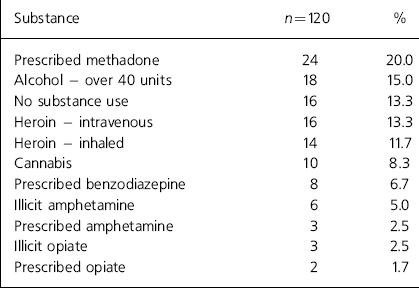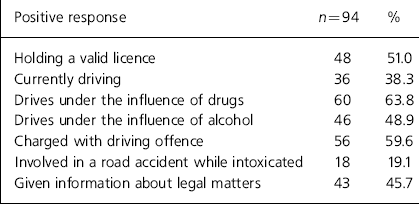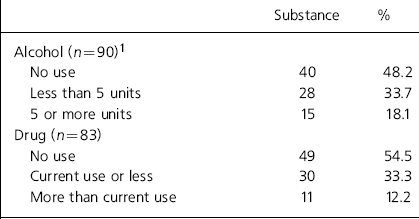The latest figures of road traffic accidents from the Department of Environment and Transport (1999) show 3423 fatalities and 39 122 serious injuries annually. The Road Traffic Act 1988 states that:
“A person who when driving or attempting to drive a motor vehicle on a road or other public place and is unfit to drive through drink or drugs is guilty of an offence.”
The dangers of driving under the influence of alcohol have been well recognised for many decades (Reference Cohen, Dearnaley and HanselCohen et al, 1958). There is increasing evidence that drug use, particularly that of tranquillisers, stimulants and cannabis, not only affects responses and judgements, but is also frequently (ranging from 7.4% to 40.9%) being found in the blood of traffic accident victims (AA Group Public Policy, 1998). There have been few studies into the problems of driving and psychiatric populations, particularly patients who misuse substances. A recently published paper by Albery et al (Reference Albery, Strang and Gossop2000) demonstrated that in a group of out-of-treatment users, 81.7% reported driving after consuming illicit drugs, 53.3% of whom held a driving conviction, and 41.4% having been involved in at least one road traffic accident.
Objectives
The aims of this study were twofold. The first objective was to establish the driving habits of a cohort of patients of a substance misuse service, and second, to establish the level of responsibility towards driving held by the cohort.
The study
Substance misusers who presented to the in-patient detoxification unit or medical out-patients during an 8-week period between November 1999 and January 2000 were asked to fill in the questionnaire. The questionnaire, amended after an initial pilot, asked about current drug use (illicit and prescribed), alcohol use and driving habits, particularly whether they had driven under the influence of drugs or alcohol; been charged with a driving offence; or been involved in an accident. Questions also asked about what they would consider a safe level of drug or alcohol use before driving and if they had been given information about legal issues concerned with substance use and driving. The Leeds Dependence Questionnaire (Reference Raistrick, Bradshaw and ToberRaistrick et al, 1994), a 10-item instrument designed to determine the level of dependence for a variety of substances, was also completed.
Findings
The population
One-hundred-and-twenty patients out of a total of 130 agreed to complete the form. The majority of patients were male (a total of 70%), with 54.2% being treated as in-patients. Of the sample, 44.2% were aged 40 and over, with only 28.3% being under 29 years. Table 1 shows the distribution of primary substance in current use by the sample. A total of 56 (47.7%) subjects were using more than one substance, the range of substances used being 0-5, a mean of 1.8 substances per subject. Primary alcohol use was defined as a total weekly consumption exceeding 40 units of alcohol; 16 subjects were drinking less than this and were not using drugs. According to the response to the Leeds Dependence Questionnaire 40.3% of patients scored 20 or over — the cut off for severe dependence.
Table 1. Primary substance use

| Substance | n = 120 | % |
|---|---|---|
| Prescribed methadone | 24 | 20.0 |
| Alcohol — over 40 units | 18 | 15.0 |
| No substance use | 16 | 13.3 |
| Heroin — intravenous | 16 | 13.3 |
| Heroin — inhaled | 14 | 11.7 |
| Cannabis | 10 | 8.3 |
| Prescribed benzodiazepine | 8 | 6.7 |
| Illicit amphetamine | 6 | 5.0 |
| Prescribed amphetamine | 3 | 2.5 |
| Illicit opiate | 3 | 2.5 |
| Prescribed opiate | 2 | 1.7 |
Driving habits
Twenty-six people had never driven a car and only the remaining 94 completed the rest of the questionnaire. Of those that had driven, only 36 (38.3%) were current drivers. The majority (75%) of current drivers used their vehicle on a daily basis Table 2 shows the response to the questions about driving habits. Of the 56 people who were charged with a driving offence, 50% had a drink-drive charge. Only 18 (19.1%) of the subjects stated that they had been involved in a road traffic accident while intoxicated, five while under the influence of drugs, seven under the influence of alcohol and six influenced by drugs and alcohol.
Table 2. Responses to driving questions

| Positive response | n = 94 | % |
|---|---|---|
| Holding a valid licence | 48 | 51.0 |
| Currently driving | 36 | 38.3 |
| Drives under the influence of drugs | 60 | 63.8 |
| Drives under the influence of alcohol | 46 | 48.9 |
| Charged with driving offence | 56 | 59.6 |
| Involved in a road accident while intoxicated | 18 | 19.1 |
| Given information about legal matters | 43 | 45.7 |
Responsibility
Six subjects, 16.6% of those currently driving, did not hold a current driving licence. Table 3 details the response to the questions of safety and substance use. For the presentation of results, the amount of alcohol use was divided into three categories: none; fewer than 5 units; and 5 units or more — which is most likely to lead to a blood alcohol level over 80 mg, the current legal cut off. There are no such legal measures for drugs, so responses were divided into none; a level less than or equal to the individual's current use; and a level that was more than the current use.
Table 3. Responses to levels of safety prior to driving

| Substance | % | |
|---|---|---|
| Alcohol (n = 90)1 | ||
| No use | 40 | 48.2 |
| Less than 5 units | 28 | 33.7 |
| 5 or more units | 15 | 18.1 |
| Drug (n = 83) | ||
| No use | 49 | 54.5 |
| Current use or less | 30 | 33.3 |
| More than current use | 11 | 12.2 |
Discussion
Relatively few (7.7%) declined to answer the questionnaire, so we achieved a good representation of those accessing the service. The population was unremarkable as a substance misuse group in contact with services, 40% being severely dependent, the majority being male and over the age of 30. There was a wide spread of substance use — opioids and alcohol most frequent — reflecting the emphasis of treatment within a clinical service. The first issue, of driving habits, shows that few were currently driving, which may be for financial or legal reasons as opposed to actual choice. Most had driven while influenced by either drugs or alcohol and had charges for driving offences, often drink—driving. This would suggest that most would feel safe combining substance use with driving even though legally many are being challenged. The low reporting of the traffic accidents suggests either a fairly high level of driving competence or an underestimation of accidents.
The second aim was to establish the degree of responsibility. Contrary to the above, responses suggest a high level of awareness of safe levels of substance use before driving, with only a small proportion seeing excess drug or alcohol use as safe. Despite this, substance misusers continue to drive following usage, possibly minimising the perceived risks attached to driving while intoxicated. One explanation of this, as proposed by Albery et al (Reference Albery, Strang and Gossop2000), is that:
“Actual experience of driving after taking drugs could create realistic knowledge and hence a more accurate perception or judgement of the different impairing effects of various illicit drugs.”
It is standard local practice at the first interview to run through driving issues with each user and so it is surprising that most people reported not being given information about legal matters. This could be explained by the regularly demonstrated poor retention of information following clinical interviews. The Driver and Vehicle Licensing Agency (1999) widely distribute information regarding fitness to drive — group one licence holders (motor car and motor cycles) who persistently use cannabis, ecstasy and other hallucinogens will have their licence revoked for 6 months. This period increases to 1 year in use of amphetamines, heroin, benzodiazepines, cocaine and methadone (except supervised oral methadone users, who are subject to annual reviews). This must be crucial information to impart to such a population.
Comparing the results to those of Albery et al (Reference Albery, Strang and Gossop2000), the two studies show very similar proportions of subjects that held driving licences, had used drugs prior to driving and had driving convictions, although they found a much higher rate of substance related accidents.
This study begins to look at how substance users may assess risks and responsibilities with regard to driving. With increasing prevalence of substance misuse the danger of driving while under the influence of substances merits further investigation. Clinicians have a responsibility to alert their patients to the risks.






eLetters
No eLetters have been published for this article.